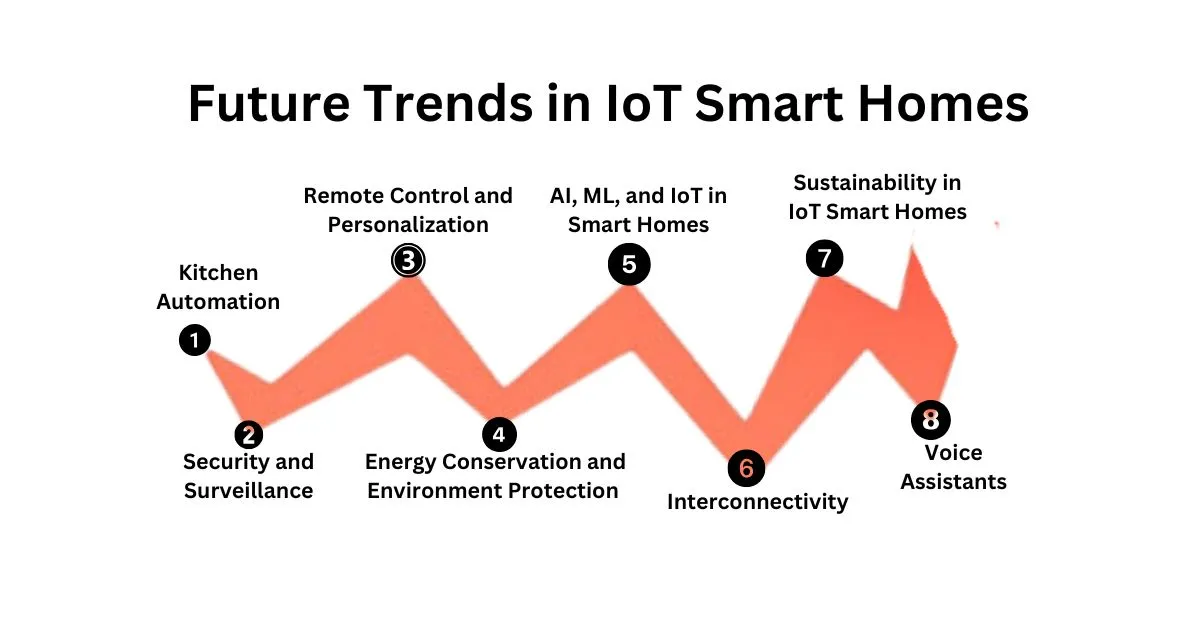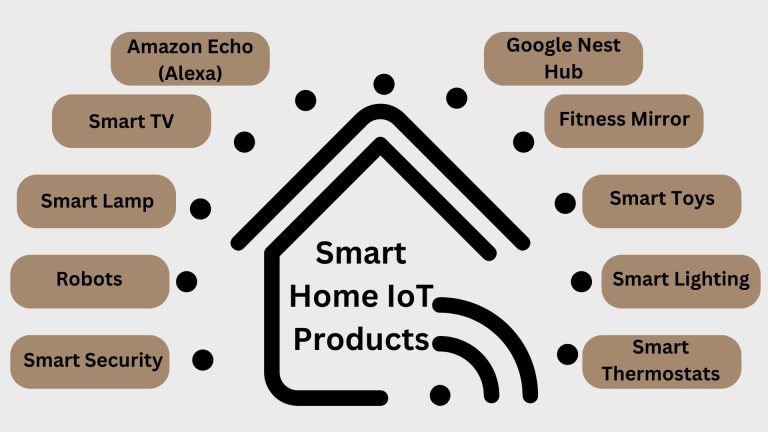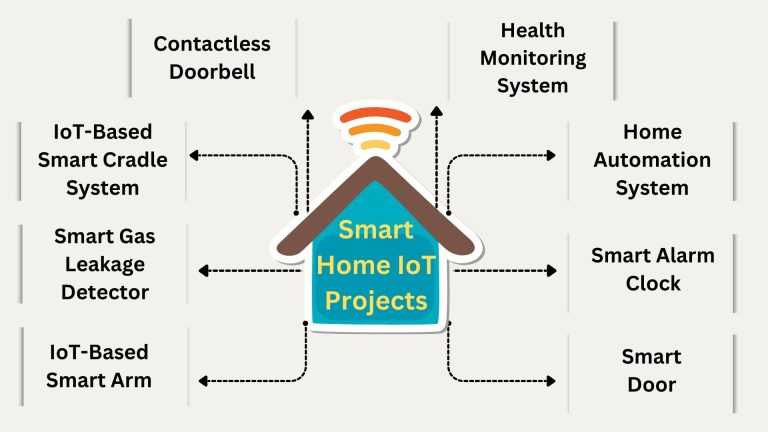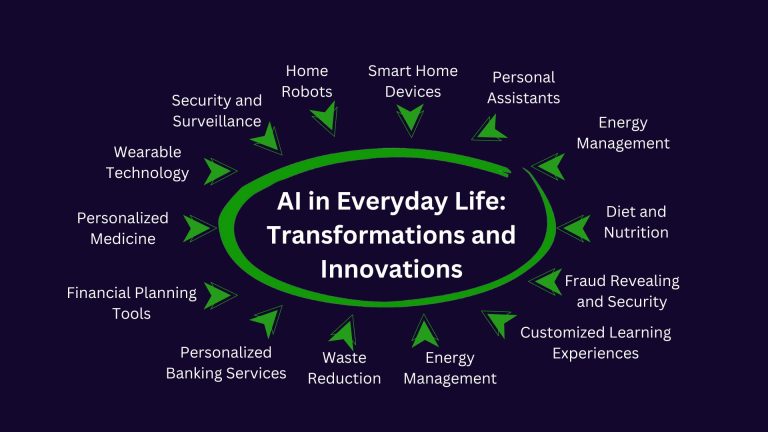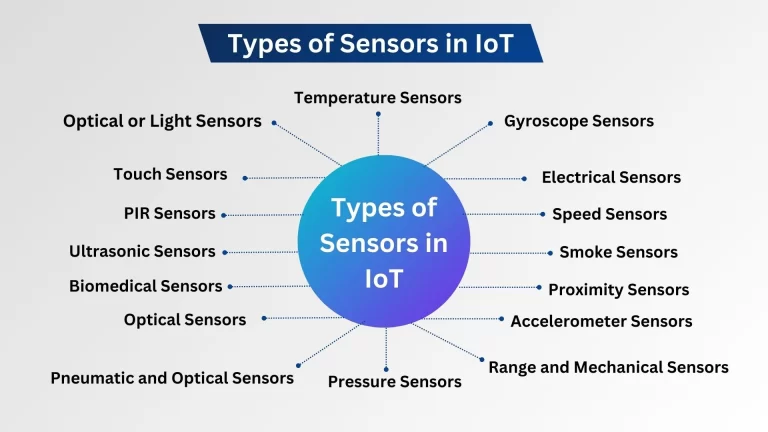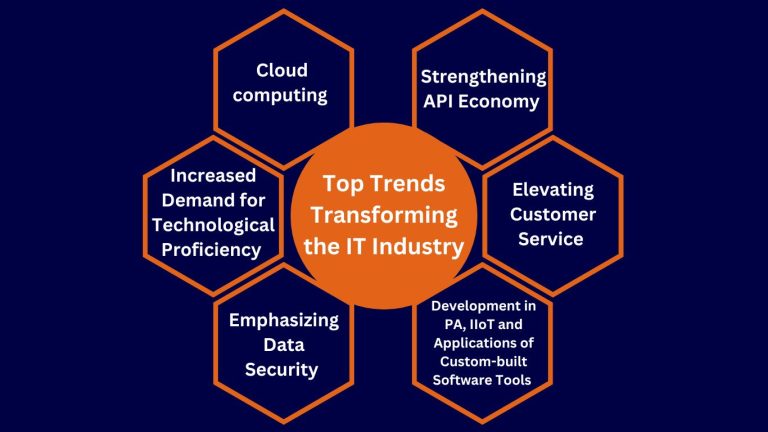Top 11 Future Trends in IoT Smart Homes
Smart Home Systems (SHS) have become crucial to contemporary life due to new technological advancements in this area. These systems use sophisticated technology to design and develop efficient and safe homes that are convenient, safe, and energy efficient. The imminent successes of IoT smart homes hold the key to evolution as an intelligent, secure, and sustainable edifice for habitation. The future of smart homes looks even brighter with expected developments in AI automation, renewable power, etc.
Proportion Of Focus For Future Trends In IoT Smart Homes
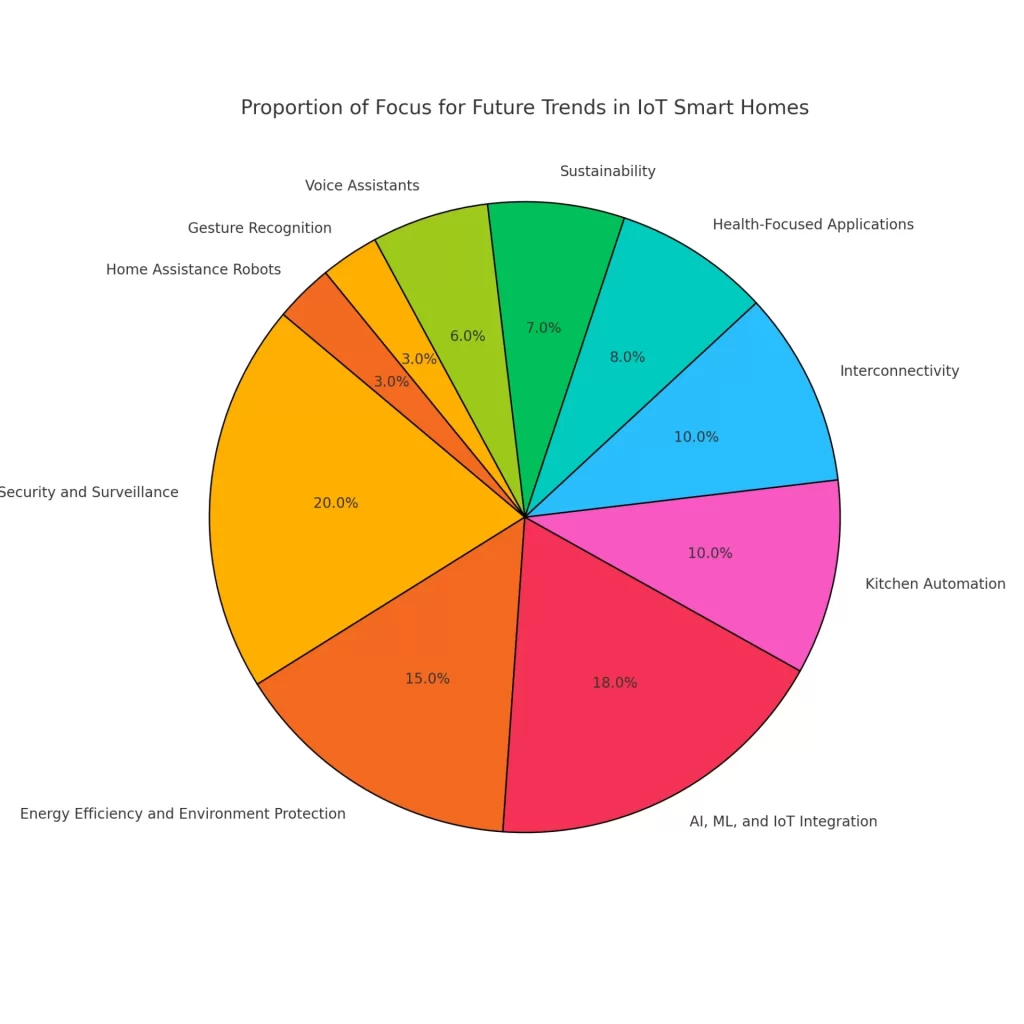
Most Popular Future Trends in IoT Smart Homes
Kitchen Automation
The kitchens are very time-consuming areas as they entail cutting, boiling, washing, and even marinating which is very tiresome and time-consuming. Smart kitchen automation is the solution to this problem, smart kitchen appliances include smart coffee makers, smart ovens, and intelligent vegetable choppers.
Smart appliances help to simplify the cooking process in the present days where automation is improved. In such devices as automated food makers, users only need to put the ingredients, start the device, and wait for the food to be prepared by the machine. This saves time for other operations, making cooking a pleasant process. Kitchen Automation is at 1 Position in Our List Most Popular Future Trends in IoT Smart Homes
Security and Surveillance
Protection is a necessity in any home. Smart homes provide safety with smart locks, intelligent security cameras, smart garage doors and alarms.
An example of an advanced security feature is “AssetGuard”, an intrusion detection system that is fastened to the fence: it is capable of identifying attempts to climb over or cut through the fence. “AssetGuard” informs homeowners of an impending intrusion and is solar operated, therefore environment friendly for the protection of homes. Security and Surveillance is at 2 Position in Our List Most Popular Future Trends in IoT Smart Homes
Remote Control and Personalization
Due to the IoT applications, all the elements of a smart home can be controlled from a distance. People are able to control lighting, heating and cooling, music and security systems from one gadget.
These systems also include the option of individual settings using artificial intelligence integrated into them. People can set the mood of their home to the type of mood or occasion they want, from a tranquil blue to a lively red, green, or yellow, simply by using an application on their smartphones or tablets. Remote Control and Personalization is at 3 Position in Our List Most Popular Future Trends in IoT Smart Homes
Energy Conservation and Environment Protection
Smart homes are environment friendly in aspects such as intelligent lighting systems that adapt to natural lighting conditions and switch off when the rooms are not in use. Energy conservation and environmental protection are not only a future trend of smart homes but also a need of the global rising population.
Energy monitoring systems provide actual information on the energy consumed in the household and can help in deciding how to lower energy usage. They help to create a more sustainable and less expensive environment in which people live. Energy Conservation and Environment Protection is at 4 Position in Our List Most Popular Future Trends in IoT Smart Homes
AI, ML, and IoT in Smart Homes
Artificial Intelligence and machine learning are poised to become the core technologies for the smart homes of the future, providing homes with systems that can learn from the user’s behavior. Smart homes will be able to predict and solve the needs of the users without instructions, thanks to the use of AI algorithms. It includes…
- Anticipating Needs: Daily schedules will be studied by AI algorithms and lighting and temperature will be set according to previous patterns. For instance, when a resident is in the habit of switching off the lights at night, the system will do it on its own at that time.
- Learning over Time: Smart homes will gradually become innovative as the machine learning algorithms improve, thus catering to the unique needs of the users. An AI system might detect that there is a change of season and control heating, cooling and use of appliances as required.
- Energy Efficiency: Learning from usage patterns will also enhance energy efficiency by turning off power in rooms that are not in use, or devices that are not in use, thereby saving energy costs and being eco-friendly. AI, ML, and IoT in Smart Homes is at 5 Position in Our List Most Popular Future Trends in IoT Smart Homes
Find More About Eco Friendly Device
Interconnectivity
In future smart homes, all the home appliances will be flawlessly connected and will be easy to use. Connectivity is a major trend of future smart homes.
- Unified Control Platforms: Unlike having several applications for various devices, one platform will be used to command all the connected devices.
- Inter-Device Communication: Home appliances will ‘talk’ to each other in order to create the best conditions in the house. For example, if the thermostat feels that there is no one in the house, it can send a message to the security system to switch on, or if it detects high humidity, it can switch on a dehumidifier. Interconnectivity is at 6 Position in Our List Most Popular Future Trends in IoT Smart Homes
Sustainability in IoT Smart Homes
IoT devices will be developed with sustainability to allow homeowners to manage resources effectively. This will optimize the usage of resources and include following aspects:
Smart energy control will help save energy through turning off devices that are not in use, dimming lights and controlling heating based on the number of people in the room and offering energy-saving tips. It devices will be used to control the usage of water and to identify cases of leakage. A few of them may send notifications to the homeowners when there is increased water consumption; saving water and money. Sustainability in IoT Smart Homes is at 7 Position in Our List Most Popular Future Trends in IoT Smart Homes
Voice Assistants
Voice assistants in smart homes are expected to be more contextual and provide deeper natural language interaction for added comfort and ease.
Future voice assistants will interpret the voice commands and the context of the commands that are passed to them to enable them to handle more complicated commands.
Sophisticated voice assistants will handle commands with sequences without any hitch. A simple command like “I’m home” could lead to several actions; opening the door, changing of temperature, and switching on of lights. Voice Assistants is at 8 Position in Our List Most Popular Future Trends in IoT Smart Homes
Gesture Recognition: Convenient and Easy to Use Mobile Device Control
Gesture recognition will provide a convenient and non-contact method of controlling smart home devices, which will be important in addition to voice and touch interfaces.
Tasks like changing the volume, lighting, or door lock will be accomplished by gestures making it easier to operate. It will enhance convenience for disabled people who might find voice or touch control systems difficult to use. Users will be able to map gestures from one command to another, making it possible to have a very sensitive control. Gesture Recognition: Convenient and Easy to Use Mobile Device Control is at 9 Position in Our List Most Popular Future Trends in IoT Smart Homes
Health-Focused Applications
There will be smart devices to help the residents with medication management and ensure that the user takes their medication on time. By monitoring factors such as temperature, lighting, and noise, smart homes can create optimal conditions for sleep and overall wellness. It will take care of the smart home resident’s health especially those who live alone will get great benefits from this technology. Health-Focused Applications is at 10 Position in Our List Most Popular Future Trends in IoT Smart Homes
Robots for Home Assistance
Smart home convenience will be boosted by artificial intelligence in robotics. The tasks like cooking and cleaning will be performed by robots. Robots will be able to do the following chores:
- Automated Culinary Assistance: Cooking will also be done by robot chefs who will be fitted with artificial intelligence to chop, cook, and prepare food in kitchens that will be turned into cooking robots.
- Household Maintenance and Cleaning: Flooring cleaning robots will clean floors, carpets, and other surfaces and will keep the house clean without much human interference.
- Lawn and Garden Care: Outdoor robots will include mowing, watering plants, managing pests, and many other chores making outdoor maintenance easy for residents.
Robots for Home Assistance is at 11 Position in Our List Most Popular Future Trends in IoT Smart Homes
Top Future Trends in IoT Smart Homes in one Picture
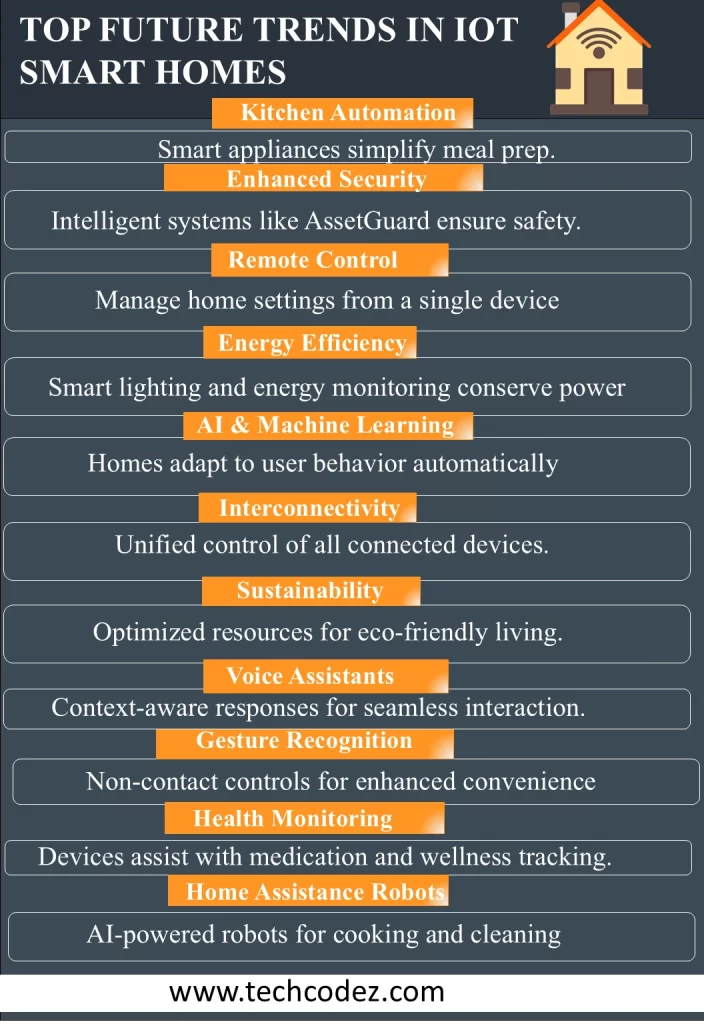
Summary of Future Trends in IoT Smart Homes with Benefits
| Future Trend | Description | Benefits |
|---|---|---|
| Kitchen Automation | Smart appliances streamline cooking tasks. | Saves time, enhances cooking ease |
| Security and Surveillance | Advanced systems like AssetGuard ensure safety. | Boosts security, eco-friendly |
| Remote Control and Personalization | Control home settings remotely and customize ambiance. | Increases convenience, mood customization |
| Energy Efficiency and Environment Protection | Smart lighting and monitoring conserve energy. | Reduces costs, eco-friendly |
| AI, ML, and IoT Integration | AI learns habits to automate routines. | Enhances convenience, saves energy |
| Interconnectivity | All devices operate on one platform seamlessly. | Enhances convenience, saves energy |
| Sustainability | Resource management for energy and water savings. | Simplifies control, cohesive functionality |
| Voice Assistants | Context-aware commands for hands-free control. | Conserves resources, lowers bills |
| Gesture Recognition | Control devices with simple gestures. | Adds convenience, easy operation |
| Health-Focused Applications | Devices aid in medication and wellness monitoring. | Supports health, aids independent living |
| Home Assistance Robots | Robots automate cooking, cleaning, and yard work. | Saves time, automates chores |
Conclusion
IoT smart homes will bring a real-life transformative experience in the future. AI, integrated systems, a secure and sustainable environment, and NLP, voice assistants, gesture control and VR are expected to modernize the concept of comfortable and effective living. When these technologies come to achievement, they will deliver an environment that is home to us, intelligent and adaptive to our needs, and one that is increasingly reflecting our rising expectations for security, sustainability, and convenience. The IoT smart home will become a proactive companion in everyday life improving people’s quality of life and living standard.
FAQ
How does AI fit in the future of IoT smart homes?
AI will be instrumental in the next generation of smart homes through the ability to learn from the users and their habits, enable the devices in the home to interact intelligently and enable an efficient use of energy for a smart home environment.
Will smart homes become safer in the future?
Yes, features like biometric authentication and encryption which are enabled by AI will enhance the security of smart homes and hence privacy.
How will IoT devices enhance sustainability in smart homes?
IoT devices of the future will promote sustainability through the better use of energy and water, the use of environmentally friendly materials, and the use of resources that will help to make people adopt sustainable lifestyles.
How will gesture recognition be applied in a novel manner?
Gesture recognition will allow users to control devices with their hands, which will be a convenient way of handling devices without having to use their hands within the house.
How does IoT help to enhance health and wellness monitoring?
IoT healthcare devices will define medication and health status, and alert patients and doctors of possible ailments, promoting healthcare as an active process.
Find More About IOT

